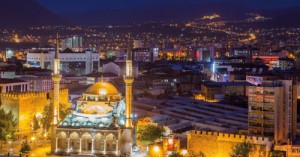 Today, Kayseri, with its rapid growth in the sense of economy, culture, sports and urbanism, without doubt, is one of the leading cities in Turkey
Today, Kayseri, with its rapid growth in the sense of economy, culture, sports and urbanism, without doubt, is one of the leading cities in Turkey
The earliest settlement around Kayseri is The Karum of Kanesh, situated 20 km to the Northeast of the city. In the center, which maintained its importance from 2800 BC to the Hellenistic Age, many documents from the Early Bronze Age, the Assyrian Trade Colonies and the Hittite Period were found. After the Hittites, the region was ruled by the Phrygians who dominated mainly the Kızılırmak River basin and Mazaka (Kayseri) came into prominence during the Phrygians. It is stated in historical sources that the Kimmerians, who arrived at the Anatolia in 676 BC, put an end to the Phrygian rule by destroying Kanesh and Mazaka. After Kanesh had lost its importance, Mazaka, situated in the North skirts of Argaios (Erciyes) that was accepted as the holy mountain of the region, came to the forefront. With the deterritorialization of the Kimmerians by the Assyrians and Lydians, Mazaka fell under the rule of the Lydians and the Medes and became an important trade center of the period.With the defeat of the Lydian King Krisos by the Persian King Kyros in 590 B.C., Mazaka, as well as Anatolia, came under the Persian rule. People migrating the region from Persia settled Argaios (Erciyes) and around it where they resembled their own states.
THE KINGDOM OF CAPPADO- CIA
In 332 B.C., Ariarathes I declared his independence as the first king of Cappadocia. While the capital of this kingdom, having ruled for 349 years until 17 A.D., was Mazaka, the name of the city was changed into Eusebia during the regin of Ariarathes V. The kingdom was renamed in 8 B.C. It was named CEASARE in honour of the Roman Emperor Caesar. From that day on it has been called Kayseri for 2000 years.
THE ROMAN PERIOD
Between the years 193-211 A.D. it was constructed the city stadium and as the other important Roman cities, it became a center for many competetions. City walls were built during the reign of the Roman Emperor Gordianus III, around 241 A.D. At the beginning of the 4th Century, people were completely Christianized and Kayseri became a center for scholarly studies of this religion. With the division of the Roman Empire into the Eastern Roman Empire and the Western Roman Empire, Kayseri became a Byzantine city as it was situated in the east. During the Byzantine period and the expeditions of the Arab and Persian armies to İstanbul, Kayseri was conquered many times.
TURKISH ERA OF KAYSERİ
The defeat of the Byzantine army by the Great Seljuk Sultan Alparslan in 1071 opened the doors of the Anatolia to Turks. 15 years after that date, around 1085 we see Kayseri both as a Turkish and Muslim city. It was seen that under the dominance of Muslim Turks, the Rums and the Armenians, the old settlers of Kayseri, gathered in a neighborhood and gradually lost control over the Bazaar, Market and trade. The city created an identity of an Islamic city in a short time through the rapid construction of Mosque, Inn, Madrasah, Bath and Fountains. Especially during the reign of the Seljuk Sultan Uluğ Keykubat (Alaeddin Keykubat I), Kayseri, the center of the Danishmends for a while, was one of the three capital cities of the Seljuk State together with Konya and Sivas. The most outstanding ones of the splendid structures that were built during the rules of the Danishmed and the Seljuks are Camii Kebir (Mosque), Güllük Mosque and Bath, Hunat Complex and Hospital – Gıyasiye Madrasa, Hacı Kılıç Complex, Lala Muhlisiddin Mosque, Sahabiye Madrasa, City Walls and Yoğunburç.
MONGOLIAN RULE
The Seljuk defeat by the Mongolians in the Battle of Köse Dağ in 1243 was a turning point in Turkish history, which led to an era of Mongolian domination. The Mongols having controlled the Anatolia for 150 years with the governors they assigned, overran all the material and moral resources of Kayseri and Anatolia. The Seljuk state, now under Mongolian rule, lost all its power and was disintegrated after Mesud II, leaving its place to small principalities (1308).
THE OTTOMAN ERA
During the reign of Fatih Sultan Mehmed, his general Gedik Ahmet Pasha annexed the regions of Karaman, Konya and Kayseri to the lands of the Ottoman Empire by terminating Karamanogullari principality (1474). Kayseri became an Ottoman district (sanjak) dependent on the Karaman province, starting 1476. In 1839, it was included into the Bozok province, and in 1867 became an independent provincial center.
RECENT PERIOD
During the Republic period, with the adoption of the new constitution in 1924, Kayseri became a city in the modern sense. It was initiated an industrialization movement by the government in Kayseri, which had been known as a trade center since the very beginning of history. Sümerbank Weaving Mill, Aircraft Factory, and Depot Maintenance Shop and Military Sewing Workshop were founded successively. After 1950, enterpreneurs of Kayseri began to canalize their capital, which they had been accumulating through commerce, into industrial investment.




